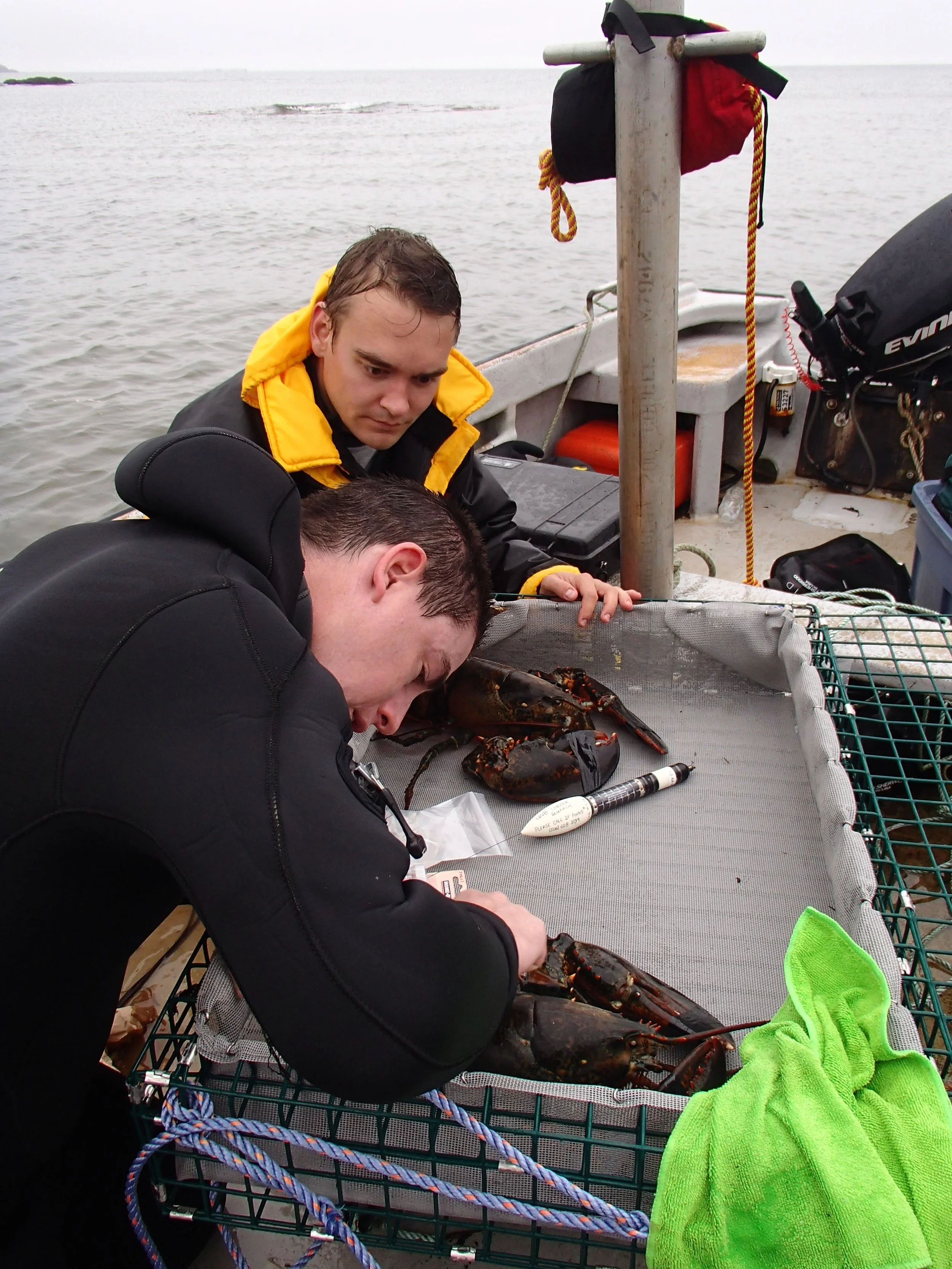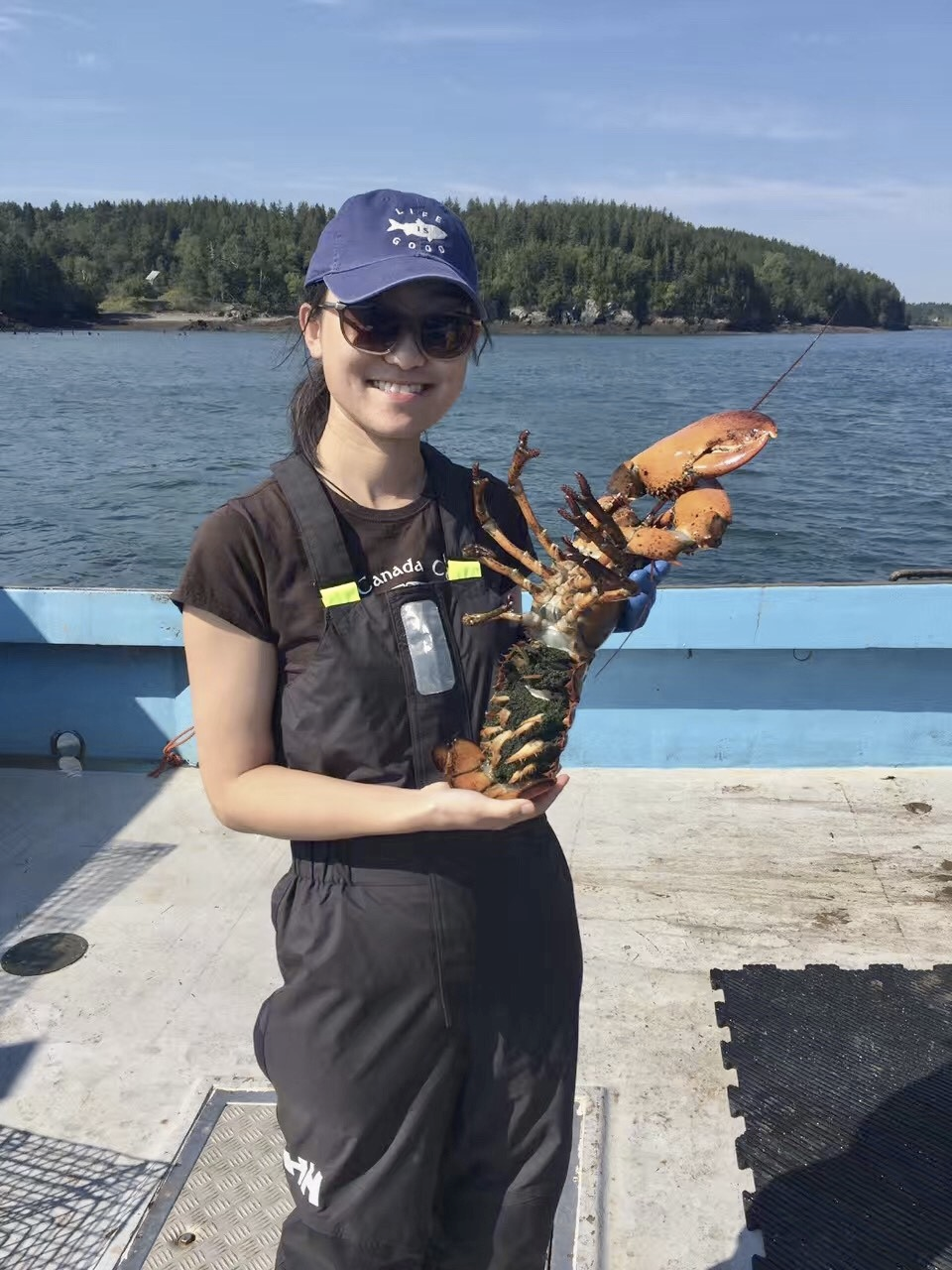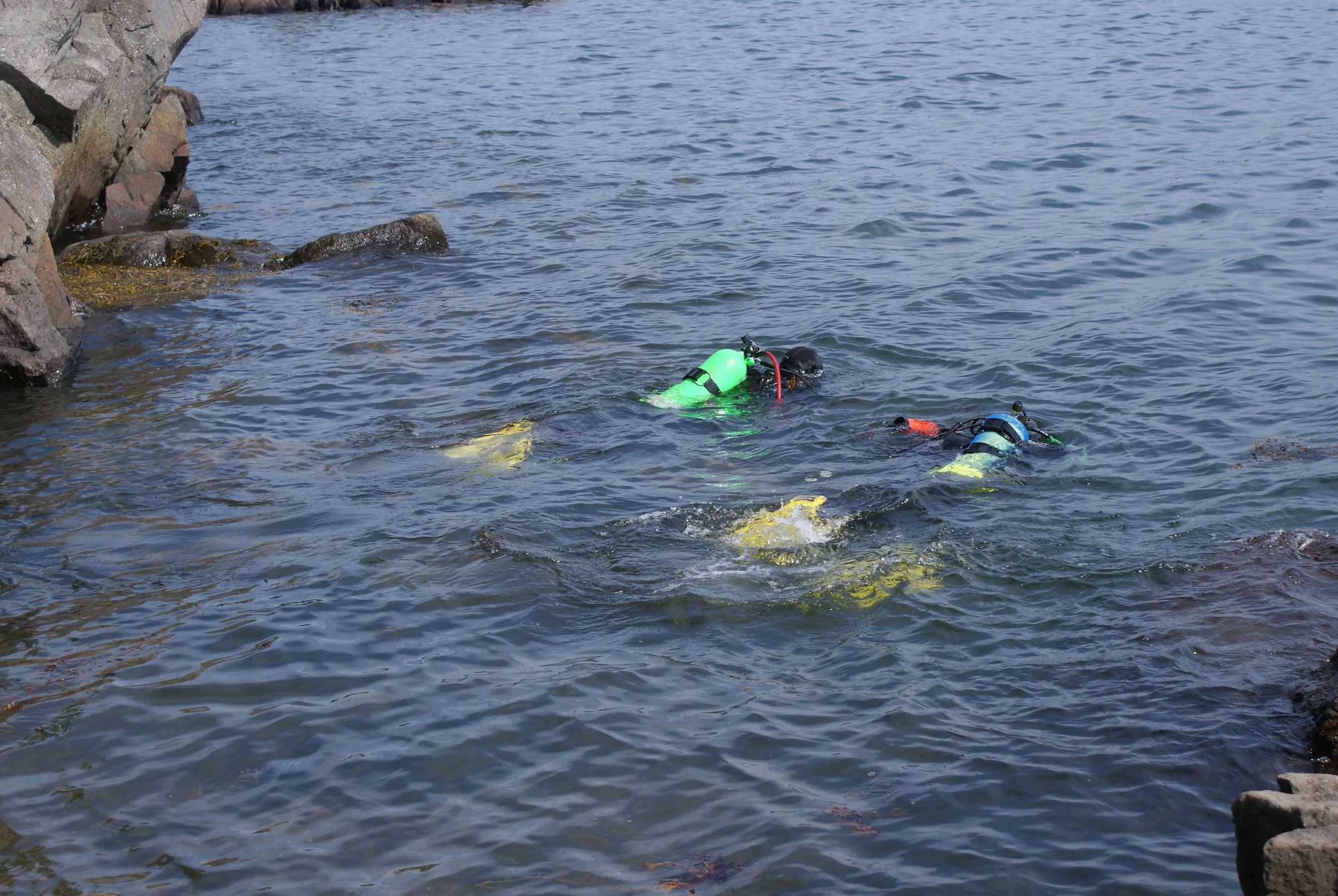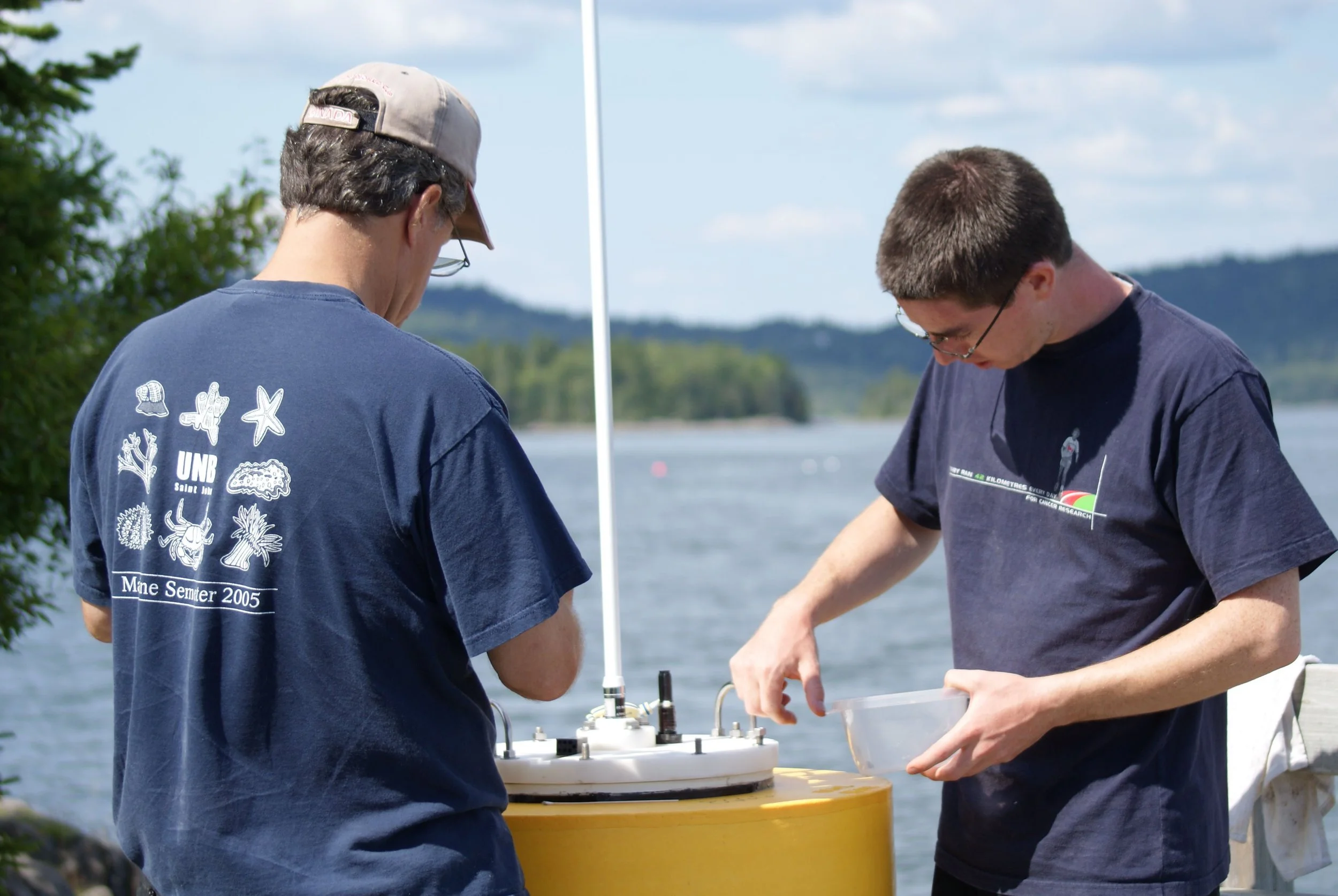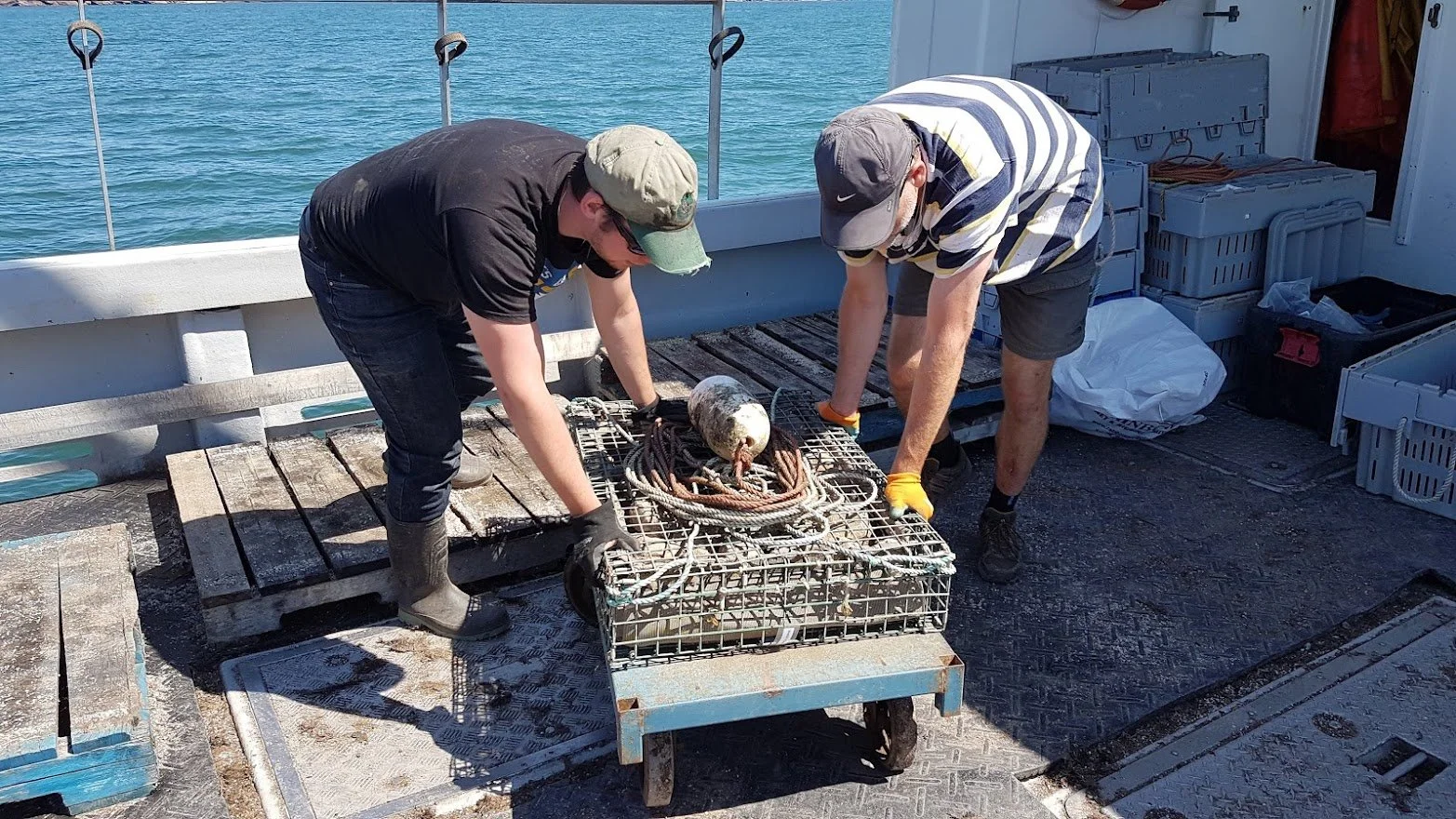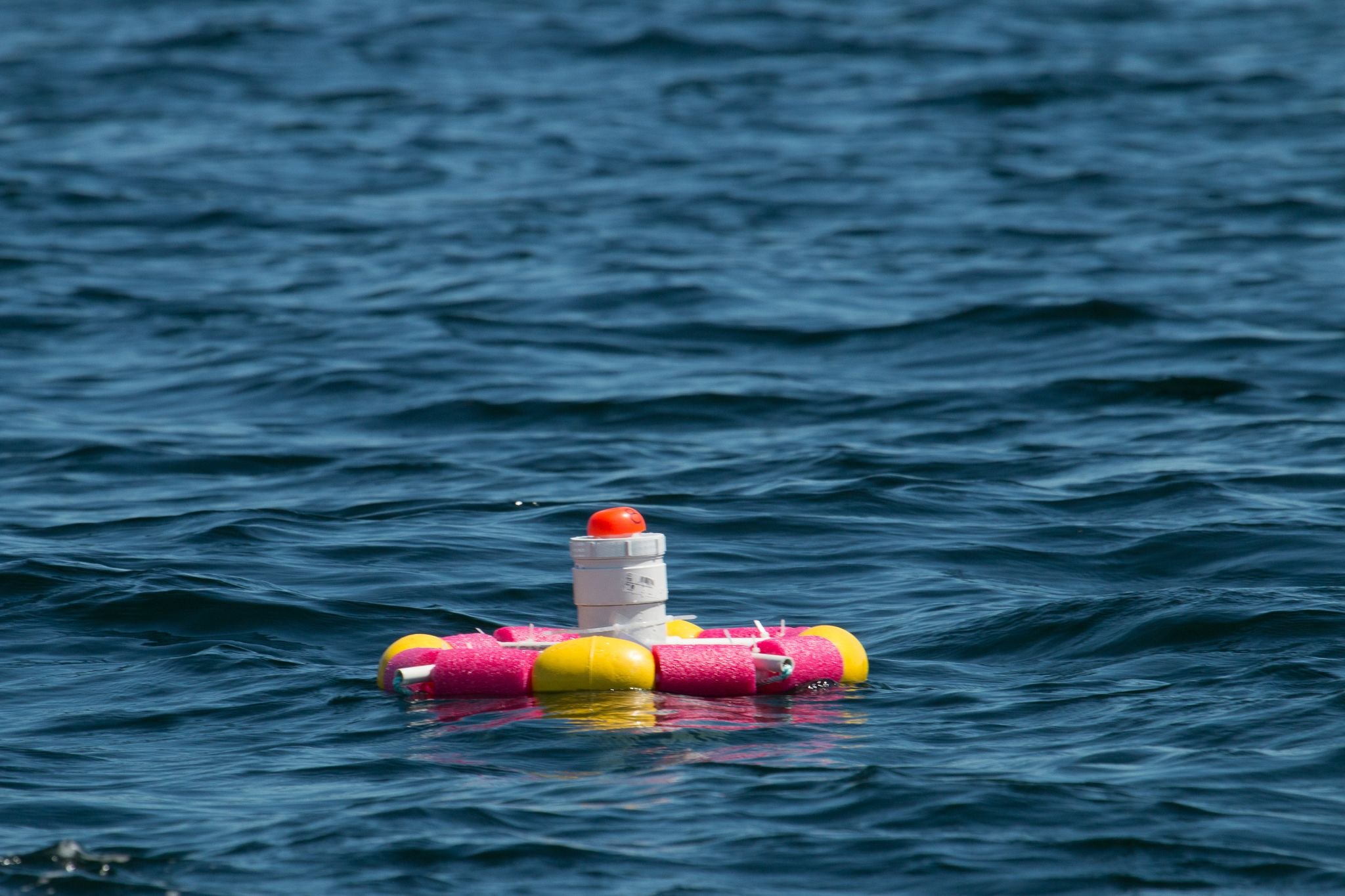
Research Program
ecology, demography, micro-evolution, and management of coastal marine invertebrates
My lab is currently engaged in many collaborative research projects with lobster harvester associations, government, and academia on different aspects of the life history and fisheries ecology of the American lobster Homarus americanus in Canada and the United States, including in relation to climate-driven changes to the resource and its ecosystem.
In 2010, I became the academic lead of a collaborative initiative known as the Lobster Node, which involved academics, government scientists and lobster harvesters in all parts of the species’ range in Canada. The Lobster Node worked on various questions identified by industry related to lobster productivity, stock structure, and connectivity.
Whereas research by the Lobster Node officially ended in 2016, the group has incorporated itself and is working at expanding its membership and creating a permanent collaborative research platform to support Canadian lobster fisheries and the communities that depend on them. I am assisting these efforts and am currently engaged in many research projects with different members of this group.
On-going research projects
-
The fecundity of individual female lobsters is an important determinant of stock productivity and an important consideration for the assessment and management of the resource. For example, the prohibition to land egg-bearing lobsters is one of Canada’s oldest fisheries regulation measures, and one that fishers are strongly committed to. It is thought that the protection of egg-bearing females may have played an important role in the continued health of lobster fisheries in Canada. Female productivity is, however, negatively affected by various fisheries-related and unrelated factors. My lab’s research under this theme includes:
Changes in female lobster size at sexual maturity in Atlantic Canada (Haarr et al. 2018)
Patterns and causes of abnormal clutches in female lobster in Atlantic Canada (Tang et al. 2018)
Sperm limitation as a cause of abnormal clutches in female lobster in Atlantic Canada (Tang et al. 2019)
Recent changes in female lobster fecundity-at-size in the Quoddy region of the Bay of Fundy (in progress)
-
Although female fecundity is an important determinant of lobster stock productivity, there is increasing evidence that the pelagic larval phase is a critical bottleneck to the conversion of this productivity into new fisheries recruits, as is the case in many marine species. This bottleneck seems at least partly related to the availability and quality of zooplankton prey in the water column during the lobster larval phase, which in turn may be partly related to hatch time. Hatch time also affects the temperatures lobster larvae experience, which in turn affects their development time and dispersal between regions and management areas. My lab’s research under this theme includes:
Climate-driven changes in hatch time of lobsters in the Gulf of St. Lawrence (Haarr et al. 2020)
In situ validation of lobster hatch time predictions off the west coast of Cape Breton Miller 2016)
In situ validation of lobster hatch time predictions in the Quoddy region of the Bay of Fundy (in progress)
Using detached embryos to study the development of American lobster embryos (in progress)
Potential effect of variation in water temperature on development time of lobster larvae (Quinn et al. 2015)
Effect of temperature on the development rate of lobster larvae from cold waters (Quinn et al. 2013)
Diet of stage IV lobster larvae in the Quoddy region of the Bay of Fundy (in progress)
Larval drift and potential connectivity among lobster fisheries (Quinn et al. 2017)
-
Structurally complex nursery grounds have long been considered an important demographic bottleneck to lobster populations and fisheries recruitment. These are sparse in most parts of the species’ range, but critical to the recruitment and survival of postlarvae and juveniles, as they provide these vulnerable stages with shelter against predators. Consistent with this understanding, recent research has shown that the abundance of young-of-year lobsters on these nursery grounds can be used to forecast fisheries recruitment 4-8 years in the future. These findings highlight the need to increase our understanding of the factors affecting successful benthic recruitment of lobsters and their eventual recruitment to fisheries. My lab’s research under this theme includes:
Importance of larval supply to spatial variation in benthic recruitment of lobsters (Sigurdsson et al. 2014)
Predation by green crab and sand shrimp on settling and recently settled lobster postlarvae (Sigurdsson et al. 2013)
The geography and bathymetry of lobster benthic recruitment in the Gulf of Maine (Wahle et al. 2013)
Quantifying the spatial scale of patchiness in benthic recruitment of lobster in the southwest Bay of Fundy (Sigurdsson et al. 2015)
Quantifying the importance of fine sediment bottom to benthic recruitment of lobsters in the Quoddy region of the Bay of Fundy (Dinning 2019 + in progress)
Size-at-age and body condition of juvenile lobsters living on cobble and mud in a mixed-bottom embayment in the Bay of Fundy (Tang et al. 2015)
Collaboration with the American Lobster Settlement Index (ALSI) initiative, led by Dr. Richard Wahle at the University of Maine
Spatial linkages between young of year and older juvenile lobsters (Burdett-Coutts et al. 2014)
Forecasting lobster fisheries recruitment based on benthic recruitment in three regions in Atlantic Canada (in progress)
-
Interspecific-interactions and movements of different benthic life stages are important to the link between lobster benthic recruitment and fisheries recruitment, and to the connectivity between regions and management areas. My lab’s research under this theme includes:
Ontogenetic changes in movement patterns and activity levels of lobsters in Anse-Bleue, southern Gulf of St. Lawrence (Morse et al. 2018)
Are benthic movements consequential to stock structure and connectivity of lobster in the southern Gulf of St. Lawrence? (Morse et al. 2018)
Movements and activity levels of juvenile lobsters in nature quantified using ultrasonic telemetry. (Morse & Rochette 2016)
Predation by green crab and sand shrimp on settling and recently settled lobster postlarvae (Sigurdsson et al. 2013)
The effect of geographic origin on interactions between adult invasive green crabs and juvenile lobsters (Haarr & Rochette 2012)
Spatial overlap and biotic interactions between sub-adult lobsters and the invasive European green crab (Lynch & Rochette 2009)
Using satellite tags to document the thermal history of migrating ovigerous female lobsters (in progress)
Using satellite tags to document the seasonal movements and resulting connectivity of adult lobsters in the Bay of Fundy (in progress)
-
With rapid advances in technology and bio-informatic capabilities, molecular tools are increasingly helping us decipher structure in marine systems characterized by high dispersal and high connectivity. My lab has had a fruitful collaboration with the Lab of Dr. Louis Bernatchez at Laval University, which has advanced our understanding of stock structure, adaptation and connectivity in American lobster. Our research under this theme includes:
Use of RAD-genotyping to reveal fine-scale genetic structuring and to provide powerful population assignment in lobster (Benestan et al. 2015)
Thermal adaptation and current-mediated population structure in lobster. (Benestan et al. 2016)
Copy number variants outperform SNPs to reveal genotype-temperature association in lobster (Dorant et al. 2020)
Comparing Pool-seq, Rapture and GBS genotyping for inferring population structure in lobster. [Dorant et al. 2019)
-
One of the more important parameters fisheries scientists rely upon to assess and manage stocks is the age of individuals, which is used to calculate growth rates, mortality rates, recruitment, and productivity. Whereas the age of marine animals can often be determined by examining calcified structures (e.g., bones, scales, otoliths, shells), this method has not been used in decapod crustaceans, due to the loss of integumental structures at each molt. My lab has partnered with Dr. Raouf Kilada to determine whether bands found in cuticular structures of Crustaceans, such as the gastric mill, might be an indicator of age. We have also partnered with Dr. Scott Pavey to explore the use of DNA methylation rates to assess the age of lobsters. Our research under this theme includes:
Direct determination of age in shrimps, crabs, and lobsters (Kilada et al. 2012)
Size-at-age and body condition of juvenile lobsters living on cobble and mud in a mixed-bottom embayment in the Bay of Fundy (Tang et al. 2015)
Investigating the use of DNA methylation rate to assess the age of lobster (in progress)
-
Salmon aquaculture and lobster fishing support two of the most important industries in Atlantic Canada, particularly in the southwest Bay of Fundy. There is concern over the impact salmon aquaculture may have on lobster in shallow coastal areas, which are important nursery grounds and hatching areas for lobsters, and preferred locations for aquaculture sites. Concerns relate mainly to the use of chemicals to treat sea lice, and their potential impact on lobster larvae and ovigerous females, as well as organic enrichment associated with fish wastes and uneaten feed. Aquaculture practices have improved over the past several decades, and aquaculture organic wastes are not necessarily detrimental to the growth of juvenile lobsters on nursery grounds. There is, however, very little data concerning the extent and outcome of interaction between these two industries in nature. Our research under this theme includes:
Lobster settlement and juvenile density “near” and “away” from salmon aquaculture sites in the Quoddy region of the Bay of Fundy (in progress)
Movement of adult lobsters in relation to salmon aquaculture sites and their production cycle in the Quoddy region of the Bay of Fundy (in progress)
Use of stable isotope analysis to assess the consumption of “aquaculture wastes” by juvenile lobster near aquaculture sites in the Quoddy region of the Bay of Fundy (in progress)
An arithmetic correction for the effect of lipid on carbon stable isotope ratios in muscle and digestive glands of lobster (Fischer-Rush et al. 2021)
-
Coastal marine habitats and organisms are changing at an unprecedented rate due to anthropogenic activities and rapid climate and ecosystem changes, and most of these changes are going unnoticed because insufficient resources are being invested in describing what lives in our oceans. Since 2010 my lab has been collaborating with Dr. Heather Hunt to monitor biodiversity of invertebrates and fishes in shallow cobble-bottom habitats of the Bay of Fundy Quoddy region, using cobble-filled collectors that we also use to monitor lobster settlement. This passive sampling tool captures larvae as they move from the water column to the sea floor, as well as juvenile and adult stages of mobile species that crawl into the bio-collectors for the shelter they provide. Our research under this theme includes:
Spatial patterns of richness and abundance of benthic decapod crustaceans and fishes in the North-west Atlantic as measured by cobble-filled bio-collectors (Hunt et al. 2017)
The effect of background substrate on recruitment of benthic marine invertebrates to subtidal cobble-filled collectors (Ellis et al. 2015)
Variability in patterns of biodiversity at different spatial scales on structurally complex cobble bottom in the Bay of Fundy Quoddy region (in progress).
Comparison of cobble-bottom biodiversity assessed by passive bio-collectors and quadrat sampling by SCUBA divers (in progress).
EARLY CAREER
Earlier in my career, before veering my attention to lobster, my research first focused on the behavioural ecology of coastal marine invertebrates, and then on the patterns, mechanisms, and constraints of adaptive phenotypic variation in these animals.
This research was mainly based on “model systems” that had been the object of much research and that were relatively easy to manipulate. These included the interaction between the predatory seastar Leptasterias polaris and the whelk Buccinum undatum in the northern Gulf of St. Lawrence, and predator-prey relationships between crabs and intertidal snails on the east and the west coasts of North America. This research involved a combination of large-scale geographic surveys to test hypotheses pertaining to the i) adaptive value, ii) micro-evolutionary mechanisms (e.g., genetic adaptation, phenotypic plasticity, evolution of reaction norms), iii) developmental mechanisms (e.g., role of environmental cues), iv) micro-evolutionary constraints (e.g., gene flow) and v) developmental constraints (e.g., correlated characters) underlying natural patterns of phenotypic variation among populations of predators and their prey.
Publications resulting from this research, from mostly before 2011, can be found HERE.
